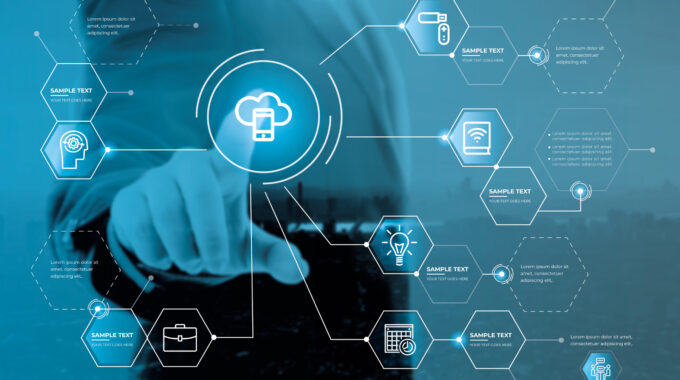Introduction In the dynamic landscape of small businesses, Point of Sale (POS) solutions emerge as…

Future-Proofing Your Business: A Comprehensive Exploration of Trends in POS Technology
Introduction
In the ever-evolving landscape of retail, staying ahead of technological advancements is not just advantageous; it’s a strategic imperative. This article delves into the trends shaping the future of Point of Sale (POS) technology, providing businesses with insights and strategies to future-proof their operations and thrive in the dynamic world of commerce.
The Evolution of POS Technology
Historical Context
Understanding the roots of POS technology provides context for its current trajectory. From traditional cash registers to the advent of digital POS systems, the evolution has been marked by a relentless pursuit of efficiency, accuracy, and enhanced customer experiences.
The Current Landscape
The contemporary POS landscape is characterized by touchscreen interfaces, cloud-based solutions, and integrations with various business functions. However, to future-proof a business, it is crucial to look beyond the current state and anticipate emerging trends.
Artificial Intelligence (AI) Integration
Enhanced Customer Interactions
AI is reshaping customer interactions at the point of sale. Predictive analytics and machine learning algorithms enable businesses to offer personalized recommendations, creating a tailored and engaging shopping experience.
Intelligent Inventory Management
AI-driven inventory management systems optimize stock levels through predictive algorithms. This not only minimizes operational costs but also ensures businesses meet customer demand efficiently, fostering customer satisfaction.
Contactless and Mobile Payments
The Rise of Contactless Transactions
Contactless payments have become a staple, driven by convenience and safety. Future POS systems seamlessly integrate contactless options, enhancing transaction speed and reducing physical touchpoints for a more hygienic shopping experience.
Mobile Wallets and Integration
The integration of mobile wallets and apps with POS systems is on the rise. This trend caters to the growing number of consumers who prefer the convenience of mobile payments, aligning retail experiences with the digital habits of modern shoppers.
Blockchain Technology in POS
Ensuring Trust and Transparency
Blockchain’s decentralized nature offers enhanced security and transparency in transactions. POS systems leveraging blockchain technology can provide secure payment processing and transparent supply chain management.
Cryptocurrency Acceptance
As cryptocurrencies gain wider acceptance, POS systems are adapting to facilitate digital currency transactions. This not only broadens payment options but also appeals to a tech-savvy customer base.
Enhanced Customer Experiences
The IoT transforms traditional retail spaces into smart environments. Connected devices, such as smart shelves and interactive displays, enhance customer experiences by providing real-time information and personalized recommendations.
Streamlined Operations Through IoT
Behind the scenes, IoT optimizes operations by providing real-time data on inventory levels, equipment health, and energy consumption. This streamlining contributes to operational efficiency and cost reduction.
Cloud-Based POS Solutions
Flexibility and Scalability
Cloud-based POS solutions offer unparalleled flexibility and scalability. Real-time data access, seamless updates, and the ability to scale operations make cloud-based systems a cornerstone of future-proofing retail businesses.
Data Security and Compliance
While the benefits are substantial, data security is paramount in cloud-based solutions. Advanced encryption protocols and compliance measures ensure that sensitive customer information remains secure in the cloud.
Augmented Reality (AR) in Retail
Elevating the Shopping Experience
AR applications in POS technology enhance the shopping experience by allowing customers to virtually try products before making a purchase decision. This interactive element not only engages customers but also aids in decision-making.
Visual Merchandising and Advertising
AR extends to visual merchandising, enabling businesses to create immersive displays and advertisements. This not only captures attention but also provides valuable insights into customer preferences for future marketing strategies.
Cybersecurity Measures in POS Technology
Proactive Threat Detection
As POS systems become more interconnected, the risk of cybersecurity threats increases. Businesses are adopting proactive measures, including AI-driven threat detection, to identify and neutralize potential security breaches before they impact operations.
Employee Training for Cybersecurity Awareness
Recognizing the human element in cybersecurity, businesses invest in comprehensive employee training. Creating a culture of cybersecurity awareness is crucial for preventing security breaches caused by human error.
Customization and Adaptability
Tailoring POS Systems to Business Needs
One-size-fits-all approaches no longer suffice. Businesses opt for customizable POS solutions, allowing them to tailor the system to specific industry requirements, unique workflows, and evolving customer expectations.
Adapting to Changing Consumer Behavior
Consumer preferences evolve rapidly. Future-proof POS systems are designed to adapt to these changes, ensuring businesses can pivot quickly to meet shifting market demands and provide a seamless customer experience.
Regulatory Compliance and Ethical Considerations
Adherence to Data Protection Laws
The regulatory landscape surrounding data protection is evolving. POS systems must align with these regulations to ensure the lawful and ethical handling of customer data, safeguarding businesses from legal repercussions.
Ethical Considerations in Data Usage
Beyond compliance, businesses are mindful of the ethical implications of data usage. Transparent communication with customers about data practices builds trust and loyalty.
The Human Element in Future POS Technology
Empowering Staff Through Technology
While technology plays a pivotal role, the human element remains irreplaceable. Future POS systems empower staff by automating routine tasks, allowing them to focus on providing exceptional customer service.
Staff Training for Tech Proficiency
Ongoing training programs ensure staff is proficient in utilizing advanced POS technology. This proficiency is crucial for harnessing the full potential of these systems and delivering an optimal customer experience.
Environmental Sustainability in POS Technology
Green Technologies and Energy Efficiency
Sustainability is a growing concern, and POS technology is not exempt. Future POS systems incorporate green technologies and energy-efficient components, aligning with businesses’ commitment to environmental responsibility.
Paperless Transactions and Receipts
The move towards paperless transactions and receipts reduces environmental impact. Digital receipts, coupled with electronic invoicing, contribute to a more sustainable and eco-friendly retail environment.
Case Studies: Pioneering POS Technology Innovations
Practical Insights from Real-world Implementations
Examining case studies provides practical insights into the successful implementation of cutting-edge POS technologies. These examples illustrate how businesses across various industries are reaping the benefits of staying at the forefront of technological advancements.
Conclusion
In navigating the trends of POS technology, businesses have the opportunity not only to stay competitive but to redefine the retail landscape. Future-proofing operations requires a strategic approach that embraces innovation, prioritizes customer experience, and safeguards against emerging challenges. By staying abreast of these trends and proactively adopting technology, businesses can position themselves as leaders in the dynamic and evolving realm of retail, ready to meet the demands of the future with resilience and agility.




